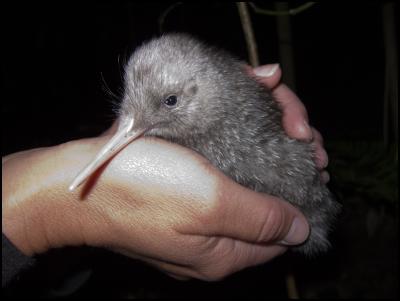Rare kiwi chicks hatch in Wellington
2011 has got off to a great start for the mainland's only little spotted kiwi (LSK) population, with researchers at ZEALANDIA this week finding the first two kiwi chicks of the new decade.
Both birds hatched on or around New Year's Eve and are already fending for themselves in the predator-free sanctuary, which is home to mainland New Zealand's only wild population of 'little spots'. In May last year, a survey showed the current population in the sanctuary to be around 100 birds, more than double the number originally released in 2000/2001.
The chicks were found by Victoria University researchers Dr Kristina Ramstad and Andrew Digby, who are studying the species.
"We've been tracking nine pairs during the breeding season as part of a study into little spotted kiwi reproductive behaviour and nesting success," said Digby.

Click for big version
"We tracked males at least once or twice a week to look for signs of nesting, such as repeated use of the same burrow, and camouflaging of the burrow entrance, then used a 'burrowscope' to look inside the nest once the adults had left at night to see whether they were incubating eggs. We've also been using sound recorders and a video camera to monitor when the males are exiting and entering the nest, since these timings can help confirm incubation and can provide some indication of when hatching is due (the males usually stay on the egg longer closer to hatch)."
Additional
information
• The female LSK lays a single egg
averaging 15-20% of her body weight, proportionally heavier
and larger than that of any other bird species!
• Once
the egg is laid, the male qwill incubate it for 65-75 days.
During this time, the female will recouperate
• Kiwi
chicks fend for themselves almost as soon as they hatch, one
reason why they are so vulnerable to mammal predation
• Little spotted kiwi are the smallest of New
Zealand's six recognised kiwi taxa.
• They were
originally found throughout the country but became extint on
the North Island by 1875 and on the South Island by the
1980s
• The entire population numbers less than 2000
birds, with the majority living on Kapiti Island
• The
ZEALANDIA population was established in 2000, with 20 birds
translocated from Kapiti Island. It is still the only
population on the
mainland
ENDS


 Bill Bennett: Comcom revisits fibre rules as competition intensifies
Bill Bennett: Comcom revisits fibre rules as competition intensifies Bill Bennett: Download Weekly Extra - InternetNZ disrupted
Bill Bennett: Download Weekly Extra - InternetNZ disrupted Community Housing Aotearoa: Reducing Debt Financing Barriers For Community Housing Providers
Community Housing Aotearoa: Reducing Debt Financing Barriers For Community Housing Providers Bill Bennett: Apple iPad Air M3 - best tablet for creators in 2025
Bill Bennett: Apple iPad Air M3 - best tablet for creators in 2025 Venture Taranaki: Taranaki Economic Outlook - Challenges Remain, But Signs Of Recovery Ahead
Venture Taranaki: Taranaki Economic Outlook - Challenges Remain, But Signs Of Recovery Ahead Grocery Action Group: Action On Supermarkets Welcomed
Grocery Action Group: Action On Supermarkets Welcomed



